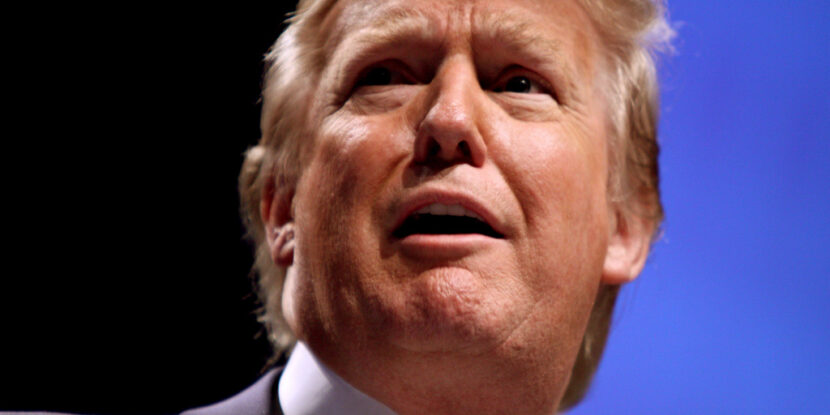
The nature of humor is described as a disparity between expectations and reality. Most jokes are built by laying a path of expectations that we follow until the end, when the jokester throws in a twist—the reality that we never saw coming.
It is therefore very fitting that Stephen Colbert chose to feature Donald Trump on the Late Show’s debut episode, because this definition of a joke also applies to Trump’s immigration platform.
“Yes, a border wall could not be simpler,” Colbert agreed with Trump’s proposal. “Just build a 95-story building, knock it over, 10,000 times. Then…then you keep the Mexicans out with a door man.”
Trump has led us down a path of expectation, telling voters that several main aspects of his plan—protect the border and protect the American worker—will be simple and beneficial ways to address the immigration question.
But of course, here comes the punch line. In reality, Trump’s policy proposals are not only far more complicated than he would have us believe, but will have adverse effects on the American economy.
Trump’s first and most talked about principle of immigration reform is his wall across the southern border. The issue in question here is not whether we should better secure our southern border—as every other legitimate immigration plan proposes—but whether we should build a 2,000-mile wall and force Mexico to pay for it.
First of all, studies by the Pew Research Center show that the number of illegal immigrants from Mexico living in the United States has actually dropped by about 1.1 million between 2007 and 2012. In addition, current demographics project that Mexican emigration will continue to drop. 15- to 24-year-olds, those most likely to consider migrating north, has fallen from 22 percent of the Mexican population in 1990 to 18 percent in 2015. Studies show the number will reach 16 percent by 2025.
Considering that immigration enforcement already constitutes half of the nation’s law enforcement budget and about half of illegal immigrants in the U.S. entered through official crossing points (visa overstay, fake documents, smuggling), securing the border is not an area in which we can afford to be wasteful or extravagant. We should focus on strategically reinforcing the 670 miles of fences already in place, rather than on erecting Trump’s first presidential monument across the southern border.
Dr. Marc Rosenblum of the Migration Policy Institute points out that a wall is only effective if border patrol agents are present to prevent people from climbing over it or digging under it. As it gets further away from heavily-trafficked urban areas, he told Fox News, “you get sharply declining returns on those fencing investments.” In other words, a wall is completely useless along most parts of the border.
Furthermore, the wall would need to cut through some privately owned land, which would either prove to be very costly to purchase, or the government would have to seize from citizens through eminent domain.
So the wall would be expensive, largely ineffective, and require trampling on the rights of many citizens, but who cares? Trump will make Mexico pay for it, and the problem is solved.
Time for another punchline. Since Mexico has already expressed that there is no chance they will be paying to construct a wall, Trump has proposed a plan to make them pay. Several of these measures, however, would have incredibly adverse effects on Americans.
For example, Trump has stated that he will impound remittance payments from wages earned by undocumented workers. Alex Nowrasteh of the Cato Institute has said that such action would require Trump to nationalize the remittance system. This money sent by workers in developed countries to relatives back home is absolutely necessary for sustaining the world’s poorest people, as it makes the world’s official foreign aid budget look like spare change. Increased regulation would greatly burden this system by driving transfer fees even higher.
Trump has also proposed raising tariffs on Mexico, but as Nowrasteh points out, this means that Americans would be paying higher taxes on Mexican goods.
Aside from his border wall proposal, Trump has also gained much attention for his concern for the American worker. His numerous proposals include greater deportation of illegal immigrants, requiring business to hire American workers before immigrant workers, and halting the issuance of green cards so that employers will have to hire from the domestic unemployment pool.
Yet another punchline: Trump’s proposal would ruin American farmers and cause a jump in our food prices.
Not to mention construction, hospitality, and manufacturing industries, Chuck Conner of the National Council of Farm Cooperatives says that undocumented immigrants make up about 60 percent of the agricultural labor force. If their workers are deported and no more green cards are issued as Trump proposes, many American farms will fail. Even now, our broken guest worker system hinders otherwise prosperous farmers from expanding their operations.
The rest of America will feel the impact when they head to the grocery store. Last year the American Farm Bureau Federation estimated that increasing deportations would cause a 6 percent rise in food prices, and in 2009 the National Milk Producers Federation predicted a 61 percent rise in milk prices if it were to lose its immigrant labor.
Countless economic analyses have shown that Trump’s immigration plan is just bad policy. And not only that, but Trump is proposing to waste American tax dollars for the sake of his dehumanizing, anti-immigrant rhetoric.
We can all enjoy the show while it lasts, but if Trump gets the nomination this November, no one will be laughing.
For an alternative (and more realistic) solution to the problems facing our present immigration system, be sure to read American Principles in Action’s Five Point Immigration Plan.
Anna Pfaff works for American Principles in Action.


